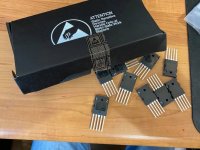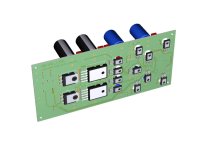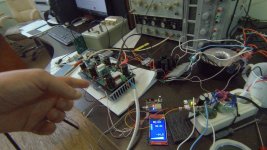Good. Please let us know what you hear, and thank you for investigating. Yes, two die mounted on one header. Not sure it was so rare. I experienced it and so did a manufacturer whom I know. More than one manufacturer had them designed into their amplifiers, so maybe they screamed enough to get the problem solved. I experienced it on experimental prototypes, so it was not from really extended use that the issue showed up. However, I don't recall them misbehaving right out of the tube.
Cheers,
Bob
Cheers,
Bob
Dont they do two die on one header for modern IGBTs with the freewheel diode built in? They would be separate processes to optimize the diode.
I think that's done for a soft/fast recovery diode of a different technology to the IGBT, rather than the intrinsic diode. Also done for half bridges etc, etc. As Bob says says, not so rare.
Which means they must have figured out how to do multiple die on those high power headers - reliably - since it seems to be routine now.
The ThermalTrak power transistors have apparently NOT been discontinued. I just looked for the NJL3281DG and NJL1302DG and found them in stock at Digikey and Mouser for about $7. Part of the confusion about them being discontinued related to the move to ROHS lead-free parts, meaning that the part numbers without the G were discontinued. Also, there was a reliability problem with the sensing diode's voltage drop jumping around unexpectedly on some devices, possibly as a result of some mechanical stress having to do with being mounted on the same header as the transistor die. Due to that reliability problem, it is possible that reliable ThermalTraks became temporarily unavailable. It appears that problem was solved quite a few years ago.I have not researched the matter to know if the ThermalTrak is really discontinued. As many of you know, I researched the ThermalTraks a great deal and wrote about them in my book, "Designing Audio Power Amplifiers". I had great success with them and felt that they made a great contribution to making BJT output stages competitive with MOSFET output stages in terms of thermal stability. I spent many hours characterizing the devices themselves and a prototype amplifier in which I used them.
It is true that some had difficulty applying them, including McIntosh. Also, the OnSemi App note was terrible and misleading. However, once one understood the devices and how to manipulate the design of the required bias spreaders (e.g., usually variants of the Vbe multiplier), very good designs were possible.
The mismatch in tempco of the Vbe to the diode was an annoyance, but readily dealt with by those who understood the needed techniques.
Having the diode monolithically implemented on the same die would have been great, but breakdown and isolation problems intervene. In practice, the sensing diode in the ThermalTrak is mounted on the same copper header as the power transistor die. This still gets it much closer thermally to where it wants to be. Attaching diodes to the case of the power transistor is better than to the heatsink, but a far cry from the thermal tracking performance of the ThermalTrak diode.
I don't recall having had trouble with any of the devices, but my sample size was fairly small. I do understand that there were some instances of reliability or defect concerns. If OnSemi was unable to such problems, it would be understandable for them to discontinue them. I seem to recall paying about $3 for them, which I thought was a great price. The 5-pin TO-264 package may have been a PIA for OnSemi.
Overall, I am very sad to see their demise, if it is true.
The Sanken devices, being Darlingtons, appear to lack the ability to have strong suck-out current for the output device. I have not had any experience with the Sanken devices, so I do not know to what extent this limitation interferes with good high-frequency, high-amplitude performance. This matter relates directly to dynamic crossover distortion.
Cheers,
Bob
As discussed above in my post #30, the ThermalTrak transistors work as they should when used in good circuits (NOT the one in the app note). Typically, one or more of the ThermalTrak diodes is used as part of a Vbe multiplier bias spreader. Use of the ThermalTrak transistors in output stages is discussed in Chapters 13.4, 17.8 and 17.9 in the second edition of my book "Designing Audio Power Amplifiers". Six different versions of a Vbe-multiplier-based bias spreader for a ThermalTrak output stage are shown in Figures 17.18 and 17.19. A complete ThermalTrak power amplifier that was built and measured is shown in Figure 17.25. The output stage is a Locanthi triple that has 2 output pairs. The ThermalTrak Vbe-multiplier-based bias spreader comprises 2 ThermalTrak diodes, one transistor, 3 resistors and one potentiometer.
The >100-Watt amplifier with +/-52-V supply rails exhibits THD+N of 0.0004% at 1 kHz driving 8 ohms, rising to only 0.0005% driving 4 ohms. At 20 kHz, THD+N is 0.0016% at 100 W into 8 ohms and 0.003% THD+N driving 4 ohms. THD-20+N is highest at 0.005% when driving 4 ohms at 3 Watts. The amplifier can produce much more output power than 100 W with higher-voltage power rails and adequate heat sinking.
Cheers,
Bob
ound them in stock at Digikey and Mouser
I also checked the manufacturer's website, onsemi.com , and they are shown "Active Production" there.
_
Attachments
I bought 25 of the NPN and the PNP , date coded 2024, a few months after the discussion here and after I failed to get responses from OnSemi or the end manufacturer I wrote to. I've done a lot of work with them since, culminating in a good working amplifier and a lot of curve matching of parameters for future designs. I'm preparing a 'missive' which I'll post here when done. I definitely echo Bob's words above.
Last edited:
I definitely look forward to that missive! I'm very glad to hear that you have had success with the ThermalTrak devices.
Cheers,
Bob
Cheers,
Bob
that are good news for owners of the amp models listed in post #1 underThe ThermalTrak power transistors have apparently NOT been discontinued. I just looked for the NJL3281DG and NJL1302DG and found them in stock at Digikey and Mouser for about $7. Part of the confusion about them being discontinued related to the move to ROHS lead-free parts, meaning that the part numbers without the G were discontinued. Also, there was a reliability problem with the sensing diode's voltage drop jumping around unexpectedly on some devices, possibly as a result of some mechanical stress having to do with being mounted on the same header as the transistor die. Due to that reliability problem, it is possible that reliable ThermalTraks became temporarily unavailable. It appears that problem was solved quite a few years ago.
As discussed above in my post #30, the ThermalTrak transistors work as they should when used in good circuits (NOT the one in the app note). Typically, one or more of the ThermalTrak diodes is used as part of a Vbe multiplier bias spreader. Use of the ThermalTrak transistors in output stages is discussed in Chapters 13.4, 17.8 and 17.9 in the second edition of my book "Designing Audio Power Amplifiers". Six different versions of a Vbe-multiplier-based bias spreader for a ThermalTrak output stage are shown in Figures 17.18 and 17.19. A complete ThermalTrak power amplifier that was built and measured is shown in Figure 17.25. The output stage is a Locanthi triple that has 2 output pairs. The ThermalTrak Vbe-multiplier-based bias spreader comprises 2 ThermalTrak diodes, one transistor, 3 resistors and one potentiometer.
The >100-Watt amplifier with +/-52-V supply rails exhibits THD+N of 0.0004% at 1 kHz driving 8 ohms, rising to only 0.0005% driving 4 ohms. At 20 kHz, THD+N is 0.0016% at 100 W into 8 ohms and 0.003% THD+N driving 4 ohms. THD-20+N is highest at 0.005% when driving 4 ohms at 3 Watts. The amplifier can produce much more output power than 100 W with higher-voltage power rails and adequate heat sinking.
Cheers,
Bob
This series are actually integrated circuits in two different versions.
One version uses only diodes for temperatur compensation resp. integral sensing diodes (usually created by an external potentiometer and an external Vbe multiplier, either as single or darlington transistor)
Datasheets therefore are here
http://www.semicon.sanken-ele.co.jp/sk_content/std03n_ds_en.pdf
http://www.semicon.sanken-ele.co.jp/sk_content/std03p_ds_en.pdf
An other version uses additional emitter degeneration resistors - go to
http://www.profusionplc.com/images/data-sheets/sap16n.pdf...
One version uses only diodes for temperatur compensation resp. integral sensing diodes (usually created by an external potentiometer and an external Vbe multiplier, either as single or darlington transistor)
Datasheets therefore are here
http://www.semicon.sanken-ele.co.jp/sk_content/std03n_ds_en.pdf
http://www.semicon.sanken-ele.co.jp/sk_content/std03p_ds_en.pdf
An other version uses additional emitter degeneration resistors - go to
http://www.profusionplc.com/images/data-sheets/sap16n.pdf...
- tiefbassuebertr
- Replies: 14
- Forum: Solid State
I would not use the Sanken transistors, since they are Darlingtons. That means that you cannot control the driver characteristics and the driver bias current, since it is set by an internal resistor. Also, using a Darlington with its driver emitter connected to the emitter of the output transistor means that the driver will operate in class AB (an arrangement that some discrete amplifiers use). I believe that it is best to operate the drivers in class A and give them plenty of idle bias to help turn off the output transistor quickly.
A resistor between the top and bottom driver emitters can accomplish this. If you center-tap this resistor, you have a useful pre-output stage output signal for test purposes. For example, you can close the feedback loop from this center tap ahead of the output stage and run the output stage open-loop and look at its open-loop distortion if you wish.
Cheers,
Bob
A resistor between the top and bottom driver emitters can accomplish this. If you center-tap this resistor, you have a useful pre-output stage output signal for test purposes. For example, you can close the feedback loop from this center tap ahead of the output stage and run the output stage open-loop and look at its open-loop distortion if you wish.
Cheers,
Bob
Thank you Bob for this advice - I had overlooked that.
The use of SAP/STD darlington versions may have been the main reason for the unreliability of the amplifier models in the previously mentioned thread and the replace by single transistor versions like NJL3281DG and NJL1302DG provides the wanted reliability.
Adding the driver transistor in the form of free wiring should not be too much of a problem.
The use of SAP/STD darlington versions may have been the main reason for the unreliability of the amplifier models in the previously mentioned thread and the replace by single transistor versions like NJL3281DG and NJL1302DG provides the wanted reliability.
Adding the driver transistor in the form of free wiring should not be too much of a problem.
- Home
- Amplifiers
- Solid State
- ThermalTrak Transistors have been discontinued




